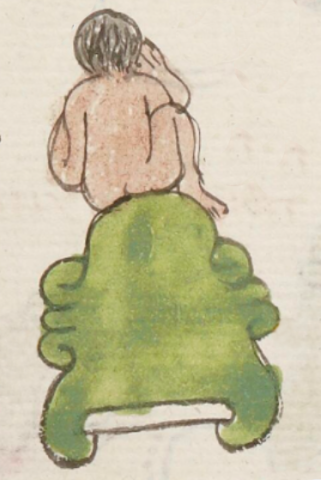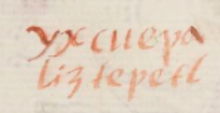Ixcuepaliztepec (TR28r)
This compound glyph for the place name Ixcuepaliztepec shows a person on the top of the frontal view of a bell-shaped hill or mountain (tepetl), or -tepec, on or at the hills or mountain]. The person sitting on top of the hill has his knees up, which is the sitting posture of a man. His right hand is up by his face, which is an unusual gesture. He appears to be unclothed, and he has is back to the viewer. Literally, his eyes and face (ixtli) are turned (cuepa) away. The -liztli refers to this state of being turned away. The mountain has the usual curling rocky outcroppings on its slopes and a white horizontal band toward its base.
Stephanie Wood
The overall impact of the place name could be "The Mountain That is Turned Away," with the human's position being a semantic indicator about the positioning of face of the mountain. The footprints turning different directions around the mountain, as shown in the contextualizing image, may also suggest a turning around.
Stephanie Wood
ixcuepa
liztepetl
Ixcuepaliztepetl (or better, Ixcuepaliztepec)
ca. 1550–1563
Jeff Haskett-Wood and Stephanie Wood
nombres de lugares

ix(tli), eyes, face, https://nahuatl.wired-humanities.org/content/ixtli
ixcuepaliz(tli), inside-out, https://nahuatl.wired-humanities.org/content/ixcuepaliztli
cuepa, verb, to turn, https://nahuatl.wired-humanities.org/content/cuepa
-liz(tli), deverbal noun suffix, https://nahuatl.wired-humanities.org/content/liztli
tepe(tl), hill-mountain, https://nahuatl.wired-humanities.org/content/tepetl
En la Montaña de Espaldas
Stephanie Wood
Telleriano-Remensis Codex, folio 28 recto, MS Mexicain 385, Gallica digital collection, https://gallica.bnf.fr/ark:/12148/btv1b8458267s/f81.item.zoom
The non-commercial reuse of images from the Bibliothèque nationale de France is free as long as the user is in compliance with the legislation in force and provides the citation: “Source gallica.bnf.fr / Bibliothèque nationale de France” or “Source gallica.bnf.fr / BnF.”


